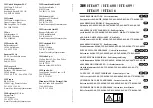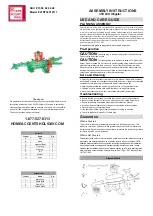
HD(i)-24V-GD-0111-EN
7
Figure 4 : Terminals’ crimping procedure
3.5.1.1
Fuse
A main fuse must be installed in the battery casing on the positive cable (+) between the batteries and the inverter, as close as
possible to the batteries. In this way (and in the event of cable rupture), the DC current would be cut at the batteries and would not
cause a fire.
Figure 5 : Fuse schema
We recommend a “CNL” type fuse, mounted on a “CNL” fuse holder like to ones included in our CM series kits. Plug one
terminal of the small and the long cable’s sections on the fuse holder, as illustrated in figure 5, and install the fuse. Without
tightening them too much, the terminals must be solidly fixed onto the fuse holder, and must not be able to move around.
CAUTION!
Not installing a fuse can result in fire that may cause severe injuries and/or damages.
3.5.2
Preparation of the cable connected to the negative side
Determine and cut the length of cable which you need to connect the negative side (-) of the battery to that of the inverter, without
forgetting the necessary length to allow movements due to the suspension of the cabin. Strip approximately a half-inch of
insulation from the two ends of the cable, insert the cable through the second PVC strain relief, and install good quality tin plated
terminal lugs on the stripped sections. Crimp the terminals with a hand held crimping tool (the use of a locked plier (
Vice-Grip
) is
not recommended) until the whole cable is crimped and then cover each section of stripped cable with good quality BLACK
shrinkable tubing (refer to Figure 4).
3.6
Connecting the Inverter
The next step is to make sure that the inverter is turned OFF. Insert the rubber insulators (included with the inverter) on the
terminal lugs and connect the cables (terminal lugs) to the inverter’s DC input terminals: the terminal covered with the RED shrink
tube to the positive (+) pole and the terminal covered with the BLACK shrink tube to the negative (-) pole. Make a secure
connection using the nuts included with the inverter. The terminal must not move around on the DC terminal, but it must not be
too tight either. The rubber insulators will protect the DC connections and will prevent the terminal from being touched by other
metallic pieces.































